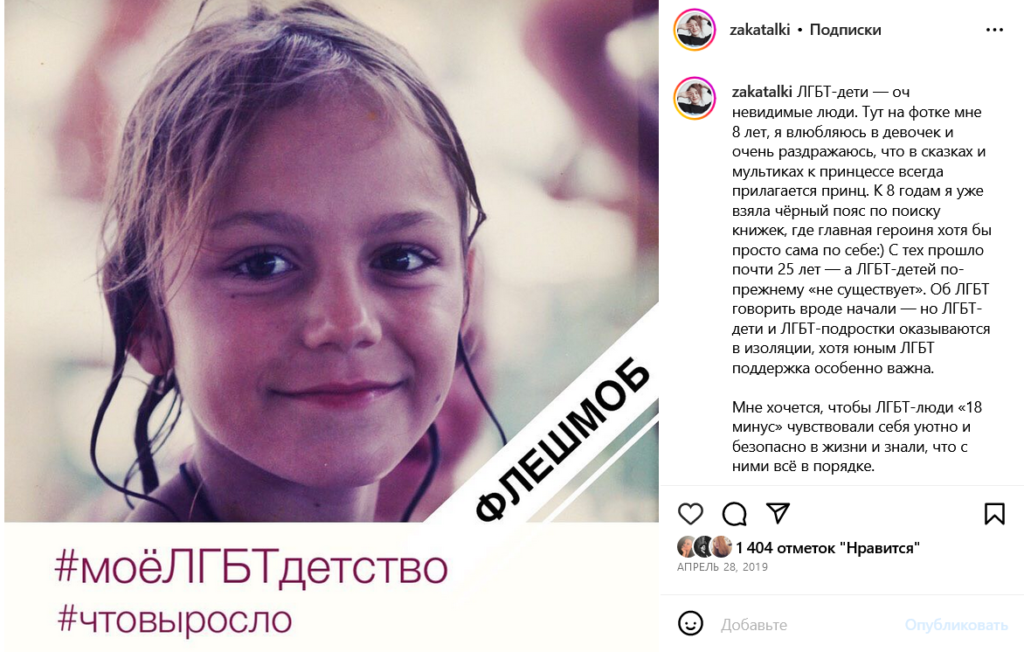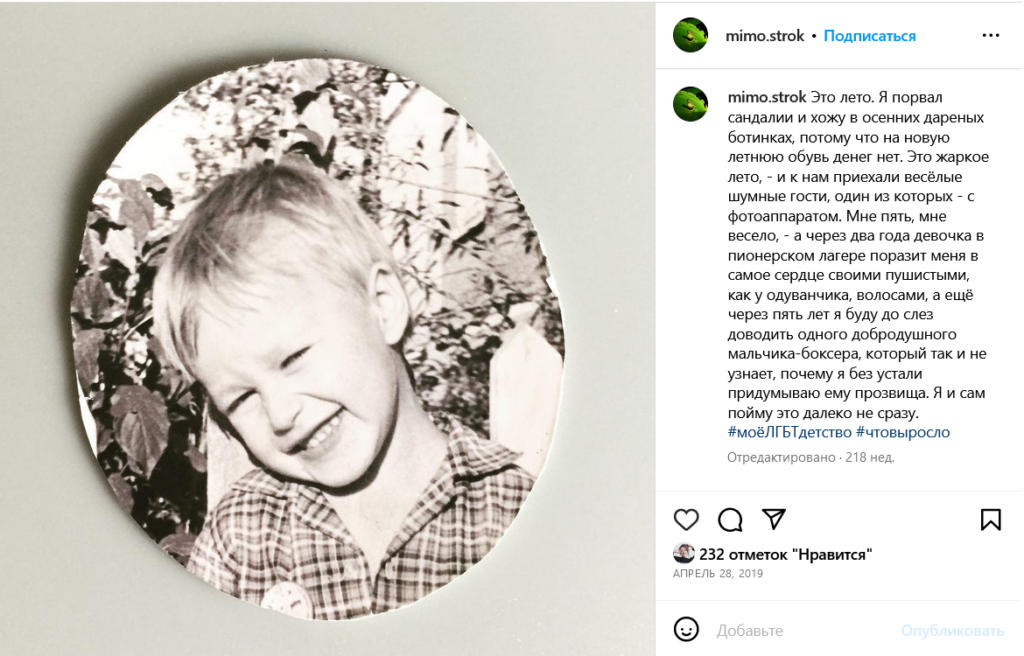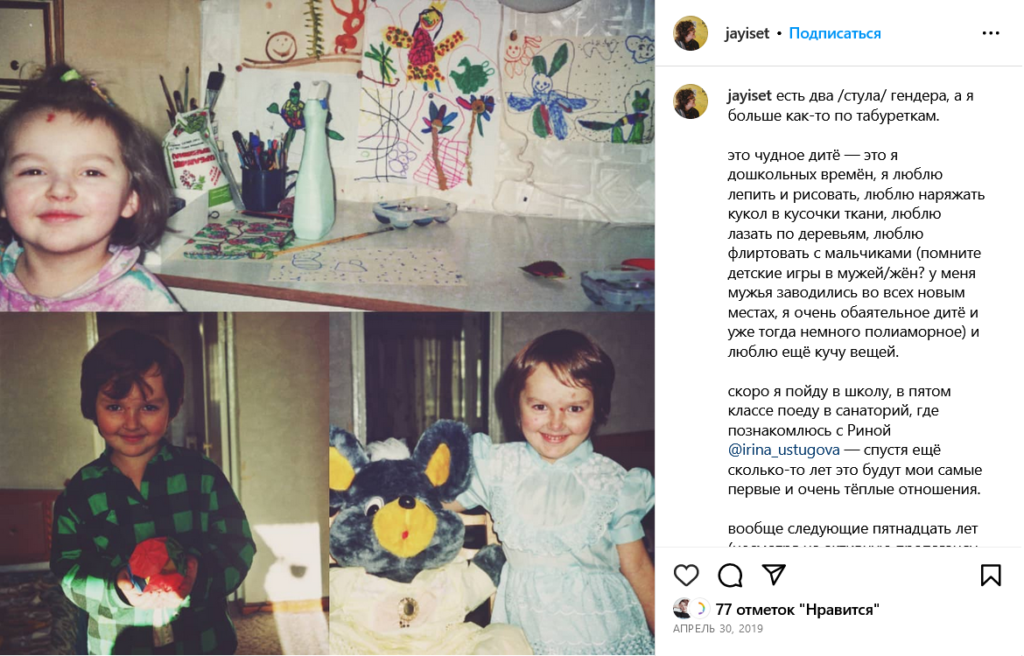In 2019, under the law forbidding gay “propaganda” against minors in Russia, a popular Lesbian sex-ed blogger and journalist Sasha Kazantseva launched an Instagram participatory viral campaign asking queer people to share their childhood photos. Here is how it all happened.
- Please describe the context in which this campaign was born. When was it? What was happening in Russia at that time?
In 2013, the Parliament passed the so-called “anti-propaganda” law that banned all exposure of minors to positive LGBTQI-related content. It basically meant that we could not publish anything that could be seen by the public.
This drew a lot of people underground. In the beginning, queer people kept quiet, many left the country, and the media stopped mentioning LGBTQI+ issues. There was a tangible feeling that LGBTQI people were being erased.
A turning point happened in 2018 when people noticed that this law hadn’t really been working and wasn’t as dangerous as they had thought. Finally, a new generation of younger and braver queers started to emerge.
Suddenly a lot of LGBTQI+ content appeared publicly again. There was a boom in the queer blogosphere. Even commercial brands started using queer people in their ads.
Was this change sudden? I’d say yes. I had a feeling that it was an outburst of the tension that had gradually been building up over the years.
However, none of this included LGBTQI minors as the law was specifically directed towards them. As a result, LGBTQI minors were deprived of many opportunities. They could not seek help from LGBTQI organisations, attend their events, or buy books about gender and sexuality, etc.
This is why I specifically wanted to support LGBTQI teenagers, because they are the most vulnerable group in the community. As LGBTQI adults who had become stronger and more powerful, I felt we had this responsibility to support them.
I would like LGBT people under 18 to feel cozy and safe in their lives and to feel reassured that there is nothing wrong with them

Caption:” LGBT children are invisible people. In this picture I am eight years old, I fall in love with girls and get annoyed that in fairy tales and Disney films princesses always fall in love with princes. By the age of eight I had already become an expert in finding books where the main female character is at least on her own. 😊 It’s now 25 years later but LGBT children still “don’t exist”. People have started talking about LGBT in general, but LGBT kids and teenagers remain isolated, even though young LGBT people are the ones who need support the most.”
- What inspired you to launch this particular campaign?
I was working for a queer media at the time and I was looking for an interesting photo project to write about. I came across this project from 1991 where two lesbians from New York posted their childhood photos all over the city, together with all the slurs and stereotypes with which they had been confronted.
The idea struck a chord with me – one’s own childhood photos! I thought: even if we cannot talk to minors, the law doesn’t forbid us to talk about our own childhoods when we realised that we were different. Sharing these stories has a dual purpose: Firstly, the public would see that there are a lot of LGBTQI+ minors out there who were being erased and for whom there was no official support because of the law. Secondly, LGBTQI minors, if they could somehow access the content, would feel supported and less isolated.
In addition, everyone likes sharing their childhood photos and everyone likes looking at other people’s childhood photos, so we thought this idea would be pretty popular.

Caption: “This sad Hussar is around 8 years old in this picture. It’s hard to remember what you were thinking and feeling at that age, but I can say for sure that I woke up early before school to be able to watch Sailor Moon, and Haruka had totally won my heart.
Looking back at childhood when you are adult, you notice a lot of things that you used to ignore (your viewpoint, feelings, the way Barbie has fun without Ken), and everything just fits into a perfect rainbow jigsaw puzzle, with the rare exception of a boy in 6th grade who also inspired some feelings.
I keep watching animation with strong women and I feel happy that I can be with the one I’ve chosen. I cry during the Pride scenes in the “Sense8” series.”
- What did the people have to do to participate?
The idea was to encourage people to post their childhood photos on Instagram and write either a short caption about their age and identity or a longer story if they felt like it, with the hashtags #моёЛГБТдетство и #чтовыросло (myLGBTchildhood and HowItTurnedOut)
Something like “Here I’m at the age of 6 and I feel I’m different from other children”, “I’m 12 years old and I’m in love with a girl” or “I’m 7 and right now I don’t understand anything but in 10-15 years I will!”

Caption: “I’m 14 here, I’m in our family’s summer home with my girlfriend, and I hate myself because loving girls is “a sin”, but I can’t help loving her.”
- How successful was it?
The campaign was quite popular without me doing anything special to promote it. The number of participants wasn’t huge – around two hundred – but it drew a lot of attention from the media.
I guess it’s because the topic of LGBTQI children was critical, and because the concept was interesting.
- Do you think that such a campaign is still possible nowadays?
I definitely think that it’s still possible. People are allowed to talk about their childhood, and there are enough people who would do it, even among those who have stayed here in Russia.
Any kind of repression generates counter-action and the more absurd the oppression is, the more you feel there are lots of people who agree with you and the braver you become.

Caption: “It’s summer, my sandals are torn and I’m wearing my autumn shoes because we don’t have enough money to buy new ones. The summer is hot, and we have a lot of funny and noisy guests, one of them has a camera. I’m five. I’m having fun, and in two years’ time a girl with hair as feathery as a dandelion will strike directly into my heart. Five years later I will make a kind-hearted boxer-boy cry. He will never know why I keep making up nicknames for him. It will take me a while to understand it myself.”
- What’s the secret of a successful viral campaign?
Virality is always unpredictable. Even the best marketing specialists have yet to understand how it all works.
However, there are some important rules to follow that might increase your chances of going viral:
– The purpose of your campaign should be very clear. In this case the protection of LGBTQI children is a clear objective
– Understand the audience you are trying to mobilse, so you speak to their motivation: LGBTQI adults were keen to share their stories. If we had appealed to a wider audience, beyond LGBTQI+ people, we might have wasted our efforts
– Create one or two original hashtags
– It should be fun and easy to take part. Often, campaigns are too serious or the rules are too strict.
It is also extremely important to think in advance about who might be offended by your campaign and how you will deal with adverse reactions. Anyway, negative reactions are also a way to draw attention to your campaign.
One last thing: draw up a list of bloggers who will share your campaign and try to get some feedback from them beforehand. It is really valuable if they tell you that, for instance, the mission is clear but the idea is not fun, or vice versa. This way, you’ll be able to improve your campaign before launching it.
- Some final inspiring words?
Draw inspiration from other campaigns, listen to their experience and keep learning about campaigning.

Caption: “This nice child is me before elementary school, I like drawing, dressing my dolls in bright clothes, climbing trees and playing with boys. I enjoy so many things. Soon I’ll go to school and in 5th grade I’ll meet Rina, some years later she will become my first and warmest relationship.
Over the following fifteen years, despite the active propaganda of heterosexuality around me, I will fall in love with boys and girls, I’ll consider myself a cisgender girl, then agender and then I’ll discover fluidity and refer to myself as queer. I’ll have the best partners of all genders, self-exploration, doubts regarding my own ‘normality’ and begin the long path of coming to peace with myself and my feelings.”

